Results of the analysis
The results have been published in a paper in ScienceExpress: Meech, K. J. et al., 2005, "Deep Impact: Observations from a Worldwide Earth-Based Campaign", ScienceExpress, 8 September. [ HTML ].
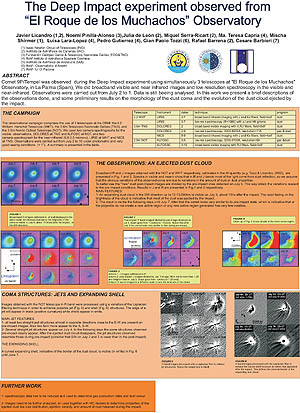 |
|
Summary of Deep Impact observations from July 3rd to 7th at the Roque de Los Muchachos Observatory: [ PDF | JPG ].
|
Before and after images
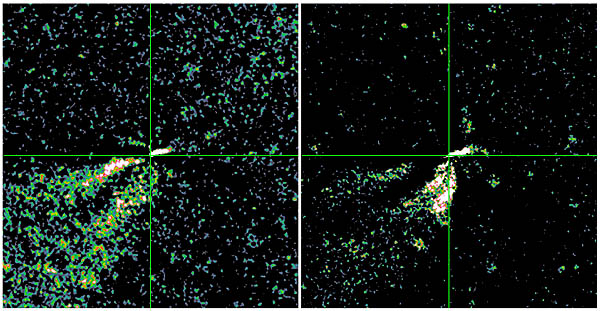 |
|
Astronomers have applied image processing techniques to the comet images below to reveal the dramatic changes in the structure of the dust 'jets' that resulted from the impact.
Before impact, three natural jets were seen to be emanating from the comet's nucleus. This all changed as can be seen in the post-impact image to the right.
Not only do the jets increase in intensity but new ones have formed, illustrating how the probe impact has breached the crust of the comet to expose the ices underneath.
The field of view in every image is 133×133 arcseconds. Image credits: Dr. Stephen Lowry, Dr. Andrew Coates, Dr. Geraint Jones and Prof. Alan Fitzsimmons. [ JPEG | TIFF ].
|
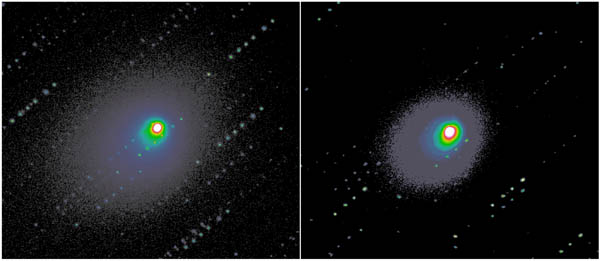 |
|
When comet Tempel 1 came into view from La Palma, some 16 hours after the NASA Deep Impact probe struck the comet, members of the La Palma Deep Impact Collaborating Observers team
were able to start tracking the target comet with the 2.5m Isaac Newtow Telescope. Both images above are a combination of 7×20 second Sloan-Gunn r' (red) filter images which isolate
the dust component of the coma. The image on the left was taken on July 3rd between 21:56 and 23:03 Universal Time, about 7 hours before impact. The image on the right was taken between 22:08
and 23:56 UT on July 4th, 16 hours after probe impact which occurred on July 4th 05:52 UT. The comet was seen to increase in brightness by a factor of two before and after the impact as seen
from this location. Even in these images the effects of the impact can be seen by the changing coma shape between the two images. North is up and East to the left. The field of view in every
image is 340×340 arcseconds. These images were acquired, processed and analysed by Dr. Stephen Lowry - on site at the Isaac Newton Telescope. Dr Stephen Lowry is a cometary astronomer
at Queen's University Belfast. Other team members are Dr. Andrew Coates, Dr. Geraint Jones and Prof. Alan Fitzsimmons. [ JPEG | TIFF ].
|
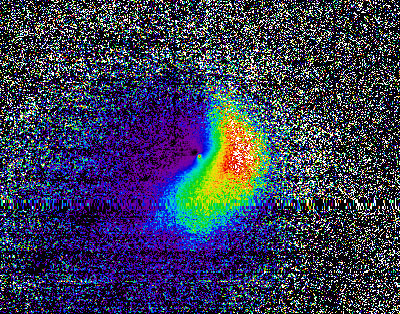 |
|
J-band image of comet Tempel 1 obtained using LIRIS on the William Herschel Telescope on July 4th. The image is the division of July 4th by July 3rd images. A clear jet structure is visible in South-West direction (on the image, North is up, East is left).
The luminosity flux over the July 4th image is about twice of the flux of the July 3rd image. The field of view of the image is 50×50 arseconds on sky which corresponds to about 32,000 kilometres at the distance of the comet.
Image credit: J. Licandro (ING-IAC), M. Schirmer (ING), J. de León and M. Serra-Ricart (IAC), N. Pinilla & A. Magazzu (FGG/TNG), M. T. Capria (IAFF-INAF). [ GIF | TIFF ]
|
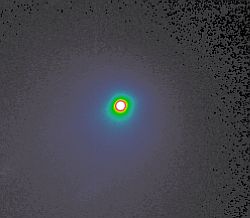 | 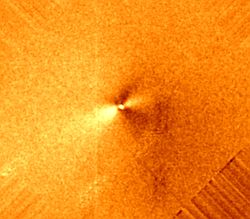 |
| Left: Comet 9P/Tempel 1 through filter J on 3 July, 2005, before the impact. Image size is 60×60 arcseconds, North to the top, East to the left.
This image was obtained using LIRIS (Long-slit Intermediate Resolution Infrared Spectrograph) on the William Herschel Telescope (image courtesy Javier Licandro). Right: Same image but filtered to show any jet structure. Two jets are clearly visible in opposite directions from South-East to North-West.
|
General information
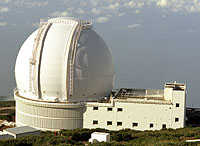 At 5:52 UT on July 4, 2005 the impactor spacecraft of NASA's Deep Impact mission will slam into the nucleus of comet 9P/Tempel 1.
An international team of astronomers led by ING astronomer Javier Licandro at the William Herschel Telescope (WHT), the Telescopio Nazional Galileo (TNG) and the Nordic Optical Telescope (NOT), and another team led by Queen's University Belfast astronomer Stephen Lowry at the Isaac Newton Telescope (INT),
will observe the encounter before and after the impact. At 5:52 UT on July 4, 2005 the impactor spacecraft of NASA's Deep Impact mission will slam into the nucleus of comet 9P/Tempel 1.
An international team of astronomers led by ING astronomer Javier Licandro at the William Herschel Telescope (WHT), the Telescopio Nazional Galileo (TNG) and the Nordic Optical Telescope (NOT), and another team led by Queen's University Belfast astronomer Stephen Lowry at the Isaac Newton Telescope (INT),
will observe the encounter before and after the impact.
Ice and dust debris will be ejected from the crater produced by the impact, revealing the material beneath. Astronomers believe that the material beneath the surface of a comet remains relatively unchanged from the solar system's formation.
Observing the nucleus of the comet after the collision can provide astronomers a glimpse on the formation of the solar system and the possible consequences of a cometary collision with our planet if this ever happens.
 A network of large telescopes around the world has been set up to continuously follow up the impact.
Due to the right location of the Roque de Los Muchachos Observatory, it will be possible to observe comet 9P/Tempel 1 before and after the impact, and provide an important set of data. A network of large telescopes around the world has been set up to continuously follow up the impact.
Due to the right location of the Roque de Los Muchachos Observatory, it will be possible to observe comet 9P/Tempel 1 before and after the impact, and provide an important set of data.
The international team led by Javier Licandro (ING) will use the WHT, the TNG and the NOT to obtain images and spectra in the optical and in the infrared with state-of-the-art instrumentation. Other members of the team are
Julia de Lon-Cruz and Miquel Serra-Ricart (IAC), Noemí Pinilla-Alonso (FGG-TNG), Gian Paolo Tozzi (Osservatorio di Arcetri), Luisa Lara López (IAA), and Cesare Barbieri and Sonia Fornasier (Osservatorio di Padova).
Astronomers at the INT will be using the Wide Field Camera (WFC) to take optical wide-field images of the coma and plasma tail.
They will be creating a series of image mosaics from multiple WFC images taken up to 8 million kilometers along the tail, to see how the structure and chemical composition of the plasma tail
changes as a result of the impact. INT team members are Stephen Lowry and Alan Fitzsimmons (QUB), Geraint Jones (Max Planck Institute) and Andrew Coates (Mullard Space Science Laboratory).
First results
The images below show the first results of the La Palma Deep Impact follow-up programme. A selection of images will be shown on this web page as soon as they become available.
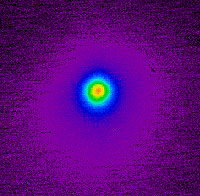 | Comet 9P/Tempel 1 through filter J on 20 June, 2005.
Image size is 10×10 arcseconds, North to the left, East to the top.
This image was obtained using adaptive optics wtih NAOMI and INGRID instruments
on the William Herschel Telescope (image courtesy Samantha Rix and Mischa Schrimer).
|
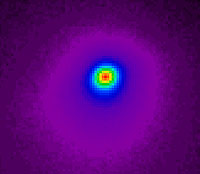 | Comet 9P/Tempel 1 through filter Sloan Gunn g' on 21 June, 2005. Image size is 20×20 arcseconds, North to the left, East to the top. This image was obtained using the Wide Field Camera on the Isaac Newton Telescope (image courtesy Mansura Jaigirdar).
|
Contacts at ING telescopes:
More information:
|



